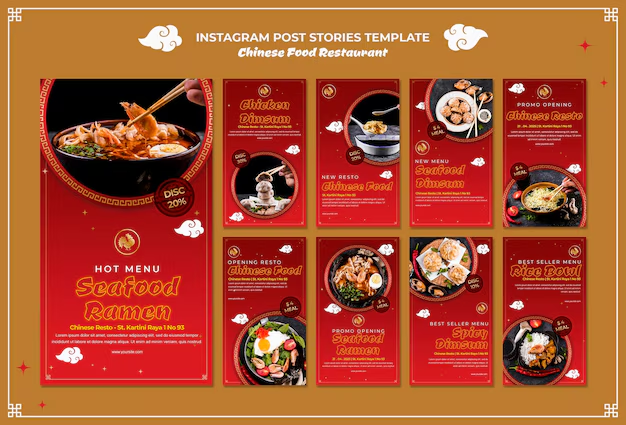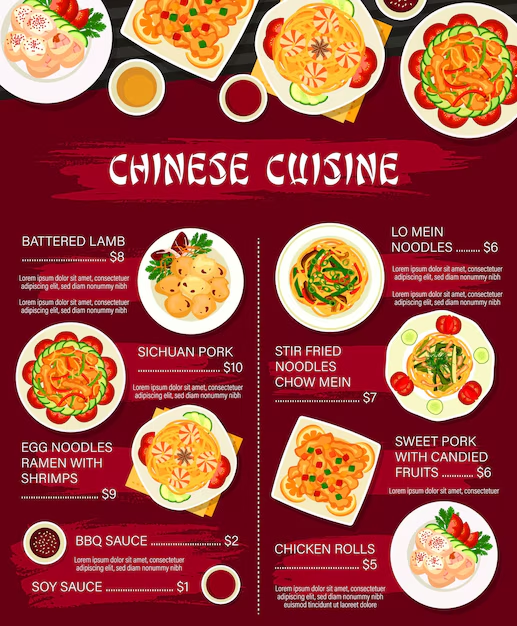In the realm of global cuisine, few can claim the diversity and rich history that Chinese food boasts. For centuries, it has tantalized taste buds with its unique flavors and intricate cooking techniques. But with such a vast culinary landscape, how does one go about designing a Chinese food menu that captures this diversity? This article aims to guide restaurant owners and enthusiasts alike in creating a menu that not only reflects the authenticity of Chinese cuisine but also satisfies the modern diner’s appetite for both tradition and innovation.
A Historical Journey Through Chinese Cuisine
Chinese cuisine is a gastronomic adventure that spans over five thousand years. Its evolution tells a story of dynastic influences, trade routes, and cultural exchanges. The diversity in regional specialties—from the fiery spices of Sichuan to the delicate flavors of Cantonese dishes—sets Chinese food apart. Each region contributes its distinct character, resulting in an array of flavors that form the backbone of any authentic Chinese food menu.
Understanding this history is crucial for anyone looking to create a menu that celebrates true Chinese flavors. It’s not just about listing popular dishes; it’s about representing a culinary heritage that has shaped the way people eat worldwide. A well-crafted menu should reflect this diversity, bringing the depth and breadth of Chinese cuisine to life for diners.
The Importance of a Well-Crafted Chinese Food Menu
A thoughtfully designed Chinese food menu goes beyond mere aesthetics. It serves as a gateway to the culture and traditions embedded in each dish. For restaurant owners, it is a vital tool for ensuring customer satisfaction and repeat business. A well-curated menu can transport diners to different regions of China, offering them an authentic culinary experience.
The menu also plays a pivotal role in setting customer expectations. Clear descriptions and well-organized sections help diners make informed choices, enhancing their overall dining experience. When diners can easily navigate a menu, they are more likely to return and recommend the restaurant to others.
Designing a Chinese Food Menu: Key Considerations
Creating a Chinese food menu involves more than just compiling a list of dishes. It requires careful thought and consideration to authentically represent the essence of Chinese cuisine. Here are a few key considerations for designing an outstanding menu:
Regional Specialties and Popular Dishes
To capture the true spirit of Chinese cuisine, it’s important to include dishes from various regions. Each area has its unique offerings, from the savory dim sum of Guangdong to the bold flavors of Hunan. Incorporating a mix of regional specialties ensures that the menu appeals to a wide range of palates.
Highlighting popular dishes like kung pao chicken or dumplings can attract customers who seek familiarity. These well-loved classics serve as an entry point to exploring more adventurous options.
Balancing Tradition and Modernity

While traditional dishes are the heart of Chinese cuisine, there’s room for innovation. Balancing traditional recipes with modern twists can attract a diverse clientele. Chefs can experiment with fusion dishes, combining classic flavors with contemporary techniques to create something new and exciting.
This blend of old and new not only caters to traditionalists but also appeals to diners looking for a novel dining experience. Offering a variety of options ensures that every guest finds something they’ll enjoy.
The Power of Visual Appeal
The visual presentation of a menu is a powerful tool in enticing customers. Beautiful imagery and artful design draw diners in, while detailed descriptions of dishes help them visualize the flavors and textures they can expect. A visually appealing menu can set the tone for the entire dining experience.
chinese food Menus should be easy to read, with clear sections and fonts that enhance readability. Thoughtful layout and design elements contribute to a seamless and enjoyable dining experience.
Pricing Strategies and Seasonal Changes
Effective pricing strategies are crucial for the success of any restaurant. A well-priced menu can maximize profitability while ensuring value for customers. It’s important to consider factors such as ingredient costs, portion sizes, and competitor pricing when setting prices.
Seasonal menu changes offer opportunities to introduce new ingredients and dishes, keeping the menu fresh and exciting. Highlighting seasonal specials can entice regular customers to try something new, while also showcasing the restaurant’s commitment to quality and creativity.
The Digital Revolution in Menu Design
In today’s digital age, a digital menu is an essential component of any successful restaurant. Digital menus offer flexibility and convenience, allowing restaurants to update offerings quickly and efficiently. They also provide an interactive experience for diners, with features such as digital ordering and payment options.
For tech-savvy diners, a digital menu enhances the dining experience by providing detailed information and visuals at their fingertips. Incorporating technology into menu design can streamline operations and improve customer satisfaction.
Wrapping Up
Crafting the perfect Chinese food menu is no small feat. It requires a deep understanding of the diverse flavors and traditions that define Chinese cuisine. By thoughtfully combining history, authenticity, and modernity, restaurant owners can create a menu that delights customers and keeps them coming back for more.
We invite you to share your favorite Chinese dishes and menu experiences in the comments below. Your insights and stories enrich our community and inspire others to explore the world of Chinese cuisine.

